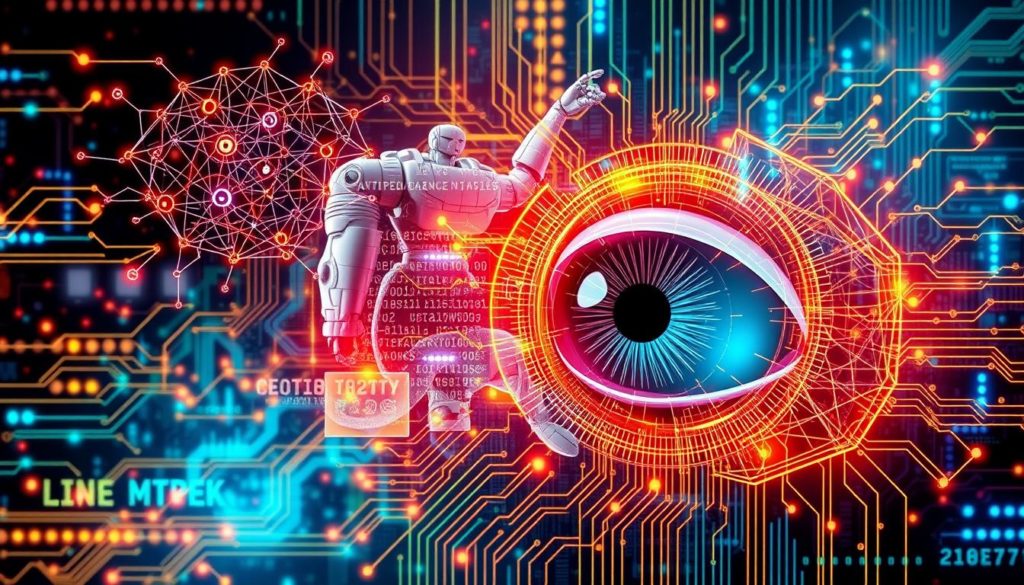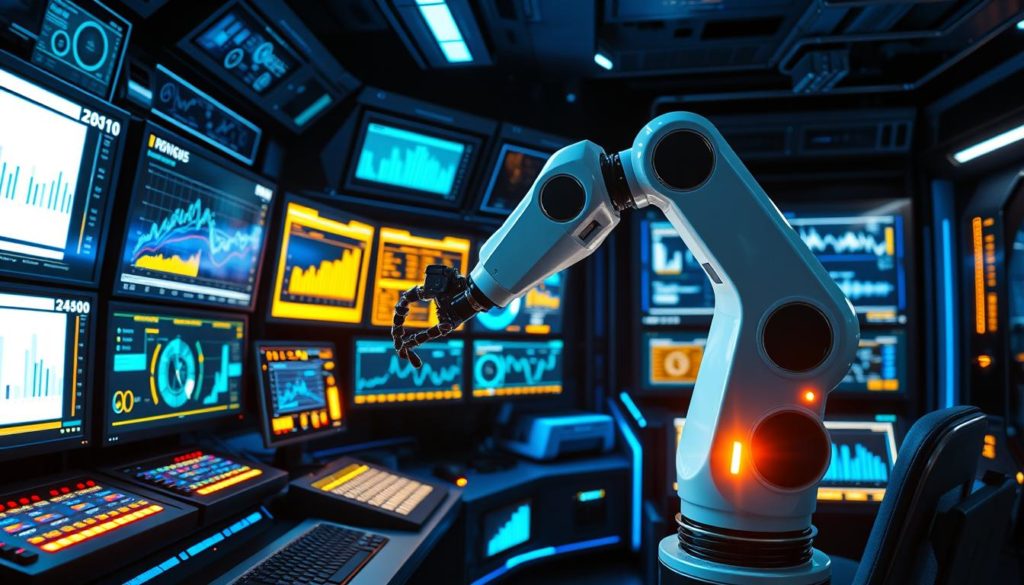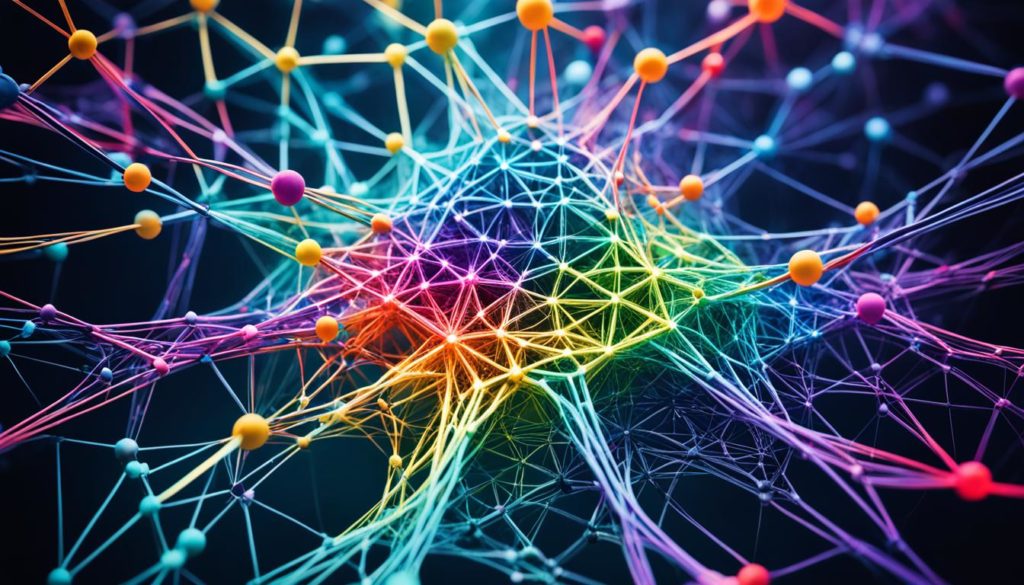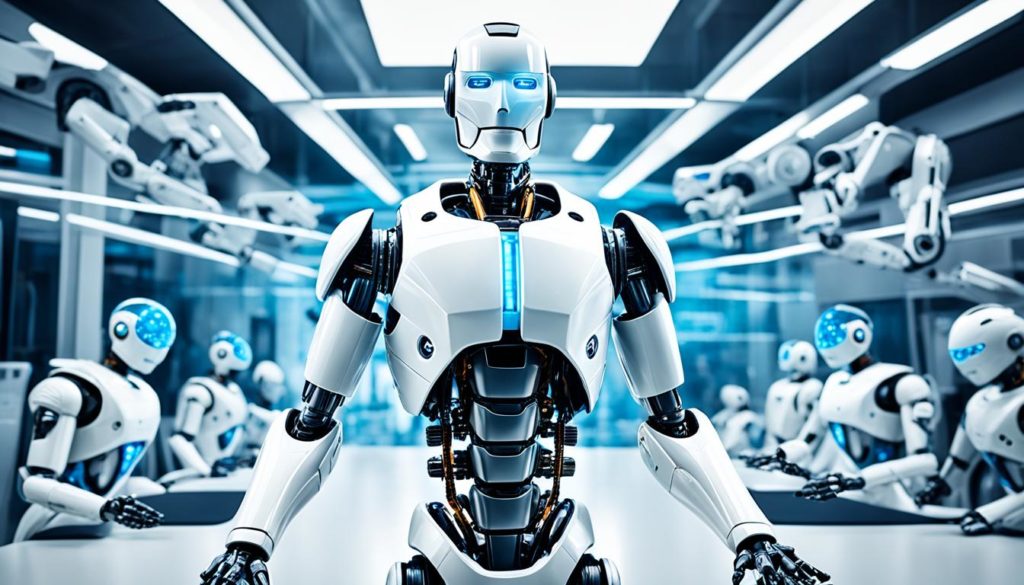
Did you know the global AI market could hit $190.61 billion by 2025? This shows how big AI’s impact is across many industries. AI, once a sci-fi dream, is now a big part of our lives. It’s changing healthcare, transportation, and more, making things more efficient and innovative.
We’re excited to dive into the different types of AI in this guide. We’ll look at the various categories and how they work. By understanding AI’s many forms, we can see how it shapes our world today. This journey will also spark thoughts on AI’s future possibilities.
Key Takeaways
- The artificial intelligence market is projected to grow substantially, reaching $190.61 billion by 2025.
- Artificial Intelligence is deeply integrated into sectors such as healthcare and transportation.
- This guide will delve into the various types of AI, based on capabilities and functionalities.
- Understanding AI’s classifications helps us appreciate its diverse applications in our world.
- We’ll explore the transformative impact of AI across different industries and the potential future advancements.
Introduction to AI and Its Impact
Artificial Intelligence is a key part of Computer Science. It aims to make machines think like humans. Now, machines can learn and adapt, just like us, thanks to AI algorithms. Recent advances in AI, like Machine Learning and Deep Learning, have made AI a big deal in many industries.
Take ChatGPT from OpenAI, for example. This AI tool uses Natural Language Processing (NLP) for smart chats. It shows how AI algorithms make our digital lives better. This is just one way AI is changing our world, making things more efficient and opening new doors.
AI is changing many areas, from healthcare to finance. It’s making things better and improving results. Now, understanding AI is key as these systems become a big part of our lives.
Let’s look at a quick overview of AI to get a better feel for it:
| AI Subfield | Key Features | Real-world Application |
|---|---|---|
| Machine Learning | Pattern recognition, Prediction | Predictive analytics in finance |
| Deep Learning | Neural networks, Advanced data processing | Image recognition in healthcare |
| Natural Language Processing (NLP) | Language understanding, Text generation | Chatbots and virtual assistants |
Exploring AI’s core shows its huge potential and how it’s changing our world and industries.
Types of AI Based on Capabilities
Understanding the different types of AI is key to seeing what artificial intelligence can do. We start with Artificial Narrow Intelligence and move up to the top levels of Artificial Super Intelligence.
Artificial Narrow Intelligence (ANI)
Narrow AI, also known as ANI, is great at doing specific tasks. It doesn’t have the general thinking skills humans do. Examples include virtual assistants like Alexa or SHRDLU, an old system. These systems work well in their own areas but don’t have the wide knowledge or adaptability of humans.
Artificial General Intelligence (AGI)
General AI goes beyond ANI, aiming to think like humans. AGI systems can do any task a human can, and they can adapt and understand many things. Even though AGI is still mostly a dream, scientists are working hard to make it real.
Artificial Super Intelligence (ASI)
Super AI, the top of AI types, is still just an idea. It would be smarter than humans in every area, from being creative to solving problems. If we ever get ASI, it could change our world in big ways. This shows the huge possibilities and challenges ahead.
For a full look at the different types of artificial intelligence, check out IBM’s detailed resource.
| Type | Capabilities | Examples |
|---|---|---|
| Narrow AI | Task-specific operations | Alexa, Google Assistant |
| General AI | Human-like cognitive abilities | Research Prototypes |
| Super AI | Superior than human intelligence | Theoretical Future Systems |
Types of AI Based on Functionality
Artificial Intelligence (AI) has different types, each with its own special features and skills. This way, we can see how AI has grown from simple tasks to maybe even thinking like us.
Reactive Machines
Reactive Machines are the simplest kind of AI. They do specific tasks based on what they’re told right now, without learning from the past. For example, IBM’s Deep Blue chess computer beat world champion Garry Kasparov. It looked at the game and used set rules and strategies.
Limited Memory AI
Limited Memory AI is more advanced than Reactive Machines. It learns from past data to make choices. This is key for things like self-driving cars. These cars learn from past moves to guess and act in real time.
Theory of Mind AI
Theory of Mind AI is a big step up. It tries to understand and react to human feelings and thoughts. These AI systems are still ideas, but they could talk to humans in a more natural way. They would know and use emotional cues to answer in a personal way.
Self-Aware AI
Self-Aware AI is the top goal for AI. These systems would think and feel like humans, making their own choices. This idea is still just that, but it shows where AI could go in the future.
Popular AI Technologies
Artificial intelligence (AI) is changing many industries with its new abilities. Several AI technologies are making a big impact and are very versatile.
Machine Learning (ML)
Machine Learning (ML) is a key AI technology. It includes supervised, unsupervised, and reinforcement learning types. These Machine Learning types help systems learn and get better from data. They are used for tasks like spotting fraud, making recommendations, and predicting trends.
It’s amazing how ML models get better with each try. They become more precise and useful over time.
Deep Learning
Deep Learning is a part of Machine Learning. It uses complex neural networks that work like the human brain. These networks are great at recognizing complex patterns. This makes them perfect for things like understanding voice commands and recognizing images.
Thanks to Deep Learning, we’ve seen huge leaps in self-driving cars and medical imaging. This shows how powerful AI technologies can be.
Natural Language Processing (NLP)
Natural Language Processing (NLP) helps machines understand and use human language. It’s used in virtual assistants, chatbots, and analyzing feelings in text. This area is getting better thanks to Cognitive Computing.
Computer Vision
Computer Vision lets machines see and act on what they see. It’s used for things like recognizing faces, spotting objects, and creating augmented reality. This tech is changing healthcare, security, and retail by making things like medical imaging and shopping easier.
These AI technologies show how AI is getting better and more useful. They help us understand the many ways AI can be used. From Machine Learning to Deep Learning and Cognitive Computing, AI is changing the world.
Breakthrough Applications of AI
AI is changing many industries as it grows. Let’s look at how it’s making a big impact in healthcare, finance, and transportation.
AI in Healthcare
Healthcare has made big strides thanks to AI. AI helps make diagnoses more accurate and quick. It also creates treatment plans just for each patient.
Robots are now a big part of surgery too. They make surgeries more precise and help patients heal faster.
AI in Finance
AI is changing finance in big ways. It helps manage risks, spot fraud, and offer financial services that fit each client’s needs. By looking at lots of data, AI makes finance more efficient and effective.
AI in Transportation
Transportation is set for a huge change with AI. Self-driving cars are leading this change, making roads safer and more efficient. Robots are also making moving goods faster and more reliable.
These changes show how AI is changing many areas of our lives. It’s clear that AI is making a big difference across different sectors.
Challenges and Ethical Considerations
AI is facing big challenges despite its potential. Ethical questions about bias and accountability are key concerns. These come from biased training data or unclear decision-making. This has led to many AI ethical issues that need careful handling for responsible AI development.
The push for responsible AI highlights the need for clear, fair, and accountable AI systems. Being open about how AI works is key to preventing misuse and making sure it fits with our values. We must make AI that’s not just smart but also right.
AI can lead to biased results, challenge our freedom, and affect our privacy. To fix this, we need to design AI in a way that fights bias and discrimination. Dealing with who is responsible for AI actions is also a big problem. Plus, we must be clear about how AI makes decisions. Without this, AI could cause big, bad effects.
As AI gets better, we must tackle these ethical and practical problems. By focusing on responsible AI, we can make sure AI helps us, not hurts us. Let’s work together to solve AI’s ethical problems and challenges. This way, technology can make our lives better, not worse.
The Future of AI
The future of AI is full of new ideas and big changes. It will touch every part of our lives, making things easier and changing industries. AI will help us do more and improve many areas.
AI’s impact on society will keep growing. It will change healthcare, finance, and more. The future of AI will bring big improvements. But, we must make sure it’s used right, keeping ethics and social good in mind.
AI will bring new changes in many areas. Here are some ways it will make things better:
- Healthcare: Better tools for diagnosing and treating patients.
- Finance: Finding fraud and analyzing data more effectively.
- Transportation: Self-driving cars and smarter traffic systems.
AI will also change education, farming, and entertainment, making our lives easier and more connected. As AI becomes a bigger part of our world, we must think about ethics.
Here are some key areas where AI will make a big difference:
| Area | Impact of AI Advancements | Potential Benefits |
|---|---|---|
| Healthcare | Advanced diagnostic and treatment options | Improved patient outcomes, personalized care |
| Finance | Enhanced data analysis and fraud prevention | Increased security, better financial management |
| Transportation | Autonomous driving, smart traffic control | Reduced accidents, efficient travel |
| Education | Personalized learning, intelligent tutoring systems | Enhanced student engagement, adaptive learning paths |
As AI becomes a bigger part of our lives, we need to balance its benefits with ethics. This ensures a good and lasting future for everyone.
Conclusion
We’ve looked at artificial intelligence and seen how it’s changing the world. It’s a technology that’s both exciting and changing the way we live and work. From its basic ideas to its many uses, AI is leading the way in many areas.
Using AI means seeing how it can make things better and more efficient in our daily lives. We’ve seen how AI helps in healthcare, finance, and many other areas. It shows how big an impact AI has on our lives today.
But we must use AI responsibly. We need to make sure it’s used in a way that’s good for everyone. The future of AI is bright, but we must approach it with care. We’ll move forward together, using AI’s benefits while keeping an eye on its ethical use.
FAQ
What are the main types of AI?
AI has different types based on what it can do. There’s Artificial Narrow Intelligence (ANI), which is good at specific tasks. Then there’s Artificial General Intelligence (AGI), which thinks like a human in many areas. And finally, there’s Artificial Super Intelligence (ASI), which is way smarter than humans.
These types also include Reactive Machines, which just react to what’s happening now. There’s Limited Memory AI, which learns from past data. Theory of Mind AI tries to understand human feelings and thoughts. And Self-Aware AI is the top goal, where machines know they exist and feel emotions.
How does AI impact our daily lives?
AI changes our lives in big ways. It helps with virtual assistants like Amazon’s Alexa. It also makes self-driving cars and helps with health by making diagnoses better.
AI makes our online experiences personal. It uses Machine Learning to improve things like banking and spot fraud.
What is Artificial Narrow Intelligence (ANI)?
ANI is AI that’s really good at doing one thing. Think of Apple’s Siri or old systems like SHRDLU. They’re great at what they do but can’t do much else.
What is Artificial General Intelligence (AGI)?
AGI is AI that thinks like a human in many ways. It can learn and apply knowledge across different areas. It’s flexible and makes decisions like we do.
What is Artificial Super Intelligence (ASI)?
ASI is when AI is way smarter than humans in every area. It would have skills and understanding we can’t even imagine. It’s still just an idea, but it’s a big goal for AI.
What are Reactive Machines in AI?
Reactive Machines are the simplest AI. They just react to what’s happening right now. IBM’s Deep Blue, the chess-playing system, is an example. It makes moves based on the current game state.
What is Limited Memory AI?
Limited Memory AI learns from past data to make decisions. It’s used in self-driving cars to help with navigation and safety. This type of AI uses past data to improve now.
What is Theory of Mind AI?
Theory of Mind AI tries to understand human feelings and thoughts. It’s still a concept, but it would let machines have deeper conversations with us. They would get social and emotional stuff.
What is Self-Aware AI?
Self-Aware AI is the top goal for AI. It means machines know they exist and feel emotions. It’s still a dream, but it’s what some aim for in AI.
What are the popular AI technologies today?
Today’s popular AI tech includes Machine Learning, Deep Learning, Natural Language Processing, and Computer Vision. These help with speech recognition, customer service, and seeing images.
How is AI used in healthcare?
AI helps in healthcare with diagnostics, making treatment plans, and predicting health trends. It looks at medical data fast, helping with accurate diagnoses and better treatment plans.
How does AI benefit the finance sector?
AI helps finance with predicting trends, managing money better, and catching fraud. Machine Learning spots patterns and oddities in financial data, making banking safer and more efficient.
How is AI transforming transportation?
AI is changing transport with self-driving cars and smarter traffic systems. These aim to make roads safer, less congested, and more efficient.
What are the ethical challenges associated with AI?
AI faces issues like bias, being accountable, and being clear about what it does. Making AI responsible means it’s fair, clear, and values human ethics. This helps avoid misuse and protects society.
What does the future of AI look like?
The future of AI is full of innovation and change across many areas. It will boost human skills, help science, and change our daily lives. But, it’s important to use AI responsibly as it grows.
Future App Studios is an award-winning software development & outsourcing company. Our team of experts is ready to craft the solution your company needs.










